
Xiphactinus is an extinct genus of large predatory marine ray-finned fish that lived during the late Albian to the late Maastrichtian. The genus grew up to 5–6 metres (16–20 ft) in length, and superficially resembled a gargantuan, fanged tarpon. It is a member of the extinct order Ichthyodectiformes, which represent close relatives of modern teleosts.
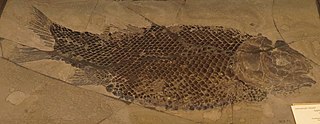
Lepidotes is an extinct genus of Mesozoic ray-finned fish. It has long been considered a wastebasket taxon, characterised by "general features, such as thick rhomboid scales and, for most of the species, by semi-tritorial or strongly tritorial dentition". with dozens of species assigned to it. Fossils attributed to Lepidotes have been found in Jurassic and Cretaceous rocks worldwide. It has been argued that Lepidotes should be restricted to species closely related to the type species L. gigas, which are only known from the Early Jurassic of Western and Central Europe, with most other species being not closely related, with other species transferred to new genera such as Scheenstia.Lepidotes belongs to Ginglymodi, a clade of fish whose only living representatives are the gars (Lepisosteidae). The type species L. gigas and close relatives are thought to be members of the family Lepidotidae, part of the order Lepisosteiformes within Ginglymodi, with other species occupying various other positions within Ginglymodi.
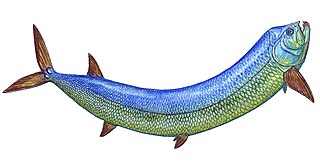
Cooyoo is an extinct genus of ichthyodectid ray-finned fish known from the Lower Cretaceous. It contains a single species, C. australis, known from the Albian-aged Toolebuc and Allaru Formations of Queensland, Australia. C. australis was originally named by Arthur Smith Woodward as a species of Portheus in 1894, which was later amended to Xiphactinus.
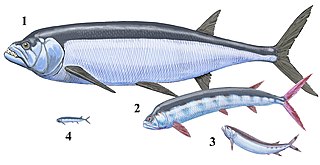
Ichthyodectiformes is an extinct order of marine stem-teleost ray-finned fish. The order is named after the genus Ichthyodectes, established by Edward Drinker Cope in 1870. Ichthyodectiforms are usually considered to be some of the closest relatives of the teleost crown group.
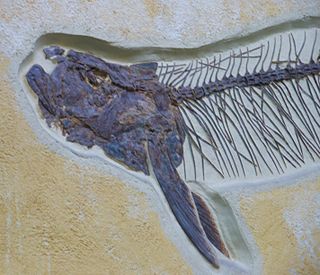
Gillicus was a relatively small, 2 metres (6.6 ft) long ichthyodectiform ray-finned fish that lived in central North America, Europe and East Asia, from the late Albian to the early Maastrichtian.

Axelrodichthys is an extinct genus of mawsoniid coelacanth from the Cretaceous of Africa, North and South America, and Europe. Several species are known, the remains of which were discovered in the Lower Cretaceous (Aptian-Albian) of Brazil, North Africa, and possibly Mexico, as well as in the Upper Cretaceous of Morocco (Cenomanian), Madagascar and France. The Axelrodichthys of the Lower Cretaceous frequented both brackish and coastal marine waters while the most recent species lived exclusively in fresh waters. The French specimens are the last known fresh water coelacanths. Most of the species of this genus reached 1 metre to 2 metres in length. Axelrodichthys was named in 1986 by John G. Maisey in honor of the American ichthyologist Herbert R. Axelrod.

Coccoderma is an extinct genus of prehistoric marine coelacanth which lived during the Late Jurassic period. Fossils have been found in Germany and France. It was small in size, about 27.5 cm. They had very long and sharp teeth.
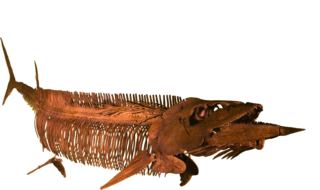
Saurodon is an extinct genus of ichthyodectiform ray-finned fish from the Late Cretaceous.

Holophagus is an extinct genus of coelacanth belonging to Latimeriidae. The type species, Holophagus gulo, is known from the Lower Jurassic marine Lias of England. Some authors have considered the genus restricted to the Lias of England.

Aidachar is an extinct genus of marine ichthyodectiform ray-finned fish from the Late Cretaceous (Cenomanian-Turonian) of Central Asia and North Africa.
Cladocyclus is an extinct genus of marine ichthyodectiform ray-finned fish from the middle Cretaceous. It was a predator of about 1.20 metres (3.9 ft) in length.

Chirocentrites is an extinct genus of marine ray-finned fish in the order Ichthyodectiformes. It contains a single species, C. coroninii, from the Late Cretaceous (Cenomanian) of Slovenia. A potential specimen is also known from the Albian-aged Pietraroja Plattenkalk of southern Italy, but it has been suggested that this specimen actually represents Cladocyclus.

Allothrissops is an extinct genus of marine ray-finned fish in the order Ichthyodectiformes, or bulldog fish. It is known from the Late Jurassic of Germany, where it has been found in the famous Solnhofen Limestone.

Anaethalion is an extinct genus of prehistoric marine and freshwater ray-finned fish related to modern tarpons and ladyfish. It is known from the Late Jurassic to the Early Cretaceous of Europe and northeasterrn Asia, roughly encompassing the Tethys Ocean.
This list of fossil fishes described in 2016 is a list of new taxa of jawless vertebrates, placoderms, acanthodians, fossil cartilaginous fishes, bony fishes and other fishes of every kind that have been described during the year 2016, as well as other significant discoveries and events related to paleontology of fishes that occurred in the year 2016. The list only includes taxa at the level of genus or species.

Foreyia is an extinct genus of coelacanth lobe-finned fish which lived during the Middle Triassic period in what is now Canton of Graubünden, Switzerland. It contains a single species F. maxkuhni.
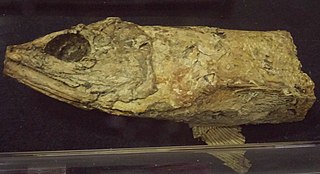
Goulmimichthys is an extinct genus of ray-finned fishes in the family Pachyrhizodontidae. The genus, first described by Cavin in 1995, is known from various Turonian age formations. The type species G. arambourgi from the Akrabou Formation in the El Rachidia Province of Morocco, and other fossils described are G. gasparini of the La Frontera Formation, Colombia, and G. roberti from the Agua Nueva Formation of Mexico.
The Sainte-Barbe Clays Formation is a geological formation in Belgium. It is found in localised areas of the northern margin of the Mons Basin, alongside the equivalently aged Hautrage and Baudour Clay Formations. It is Upper Barremian-Lower Aptian in age. It predominantly consists of laminated clay, with some lignite. It is well known for the "Iguanodon sinkhole" locality near Bernissart where many specimens of Iguanodon bernissartensis were described by Louis Dollo in the late 19th century.
This list of fossil fish research presented in 2023 is a list of new fossil taxa of jawless vertebrates, placoderms, cartilaginous fishes, bony fishes, and other fishes that were described during the year, as well as other significant discoveries and events related to paleoichthyology that occurred in 2023.

The Akrabou Formation is a Late Cretaceous -aged geological formation and Konservat-Lagerstätte in Morocco. It overlies the slightly older freshwater deposits of the Kem Kem Group, which it was once thought to be apart of. It was deposited over following the Kem Kem ecosystem's submergence by the Tethys Ocean during a marine transgression from the Cenomanian-Turonian boundary event, as part of a wider deposition of carbonate platforms across the region from the event.


















